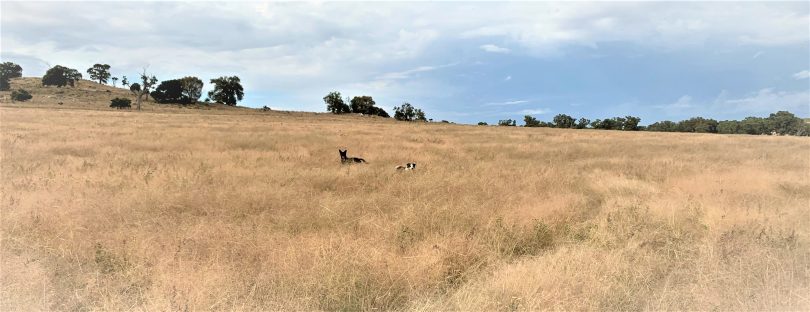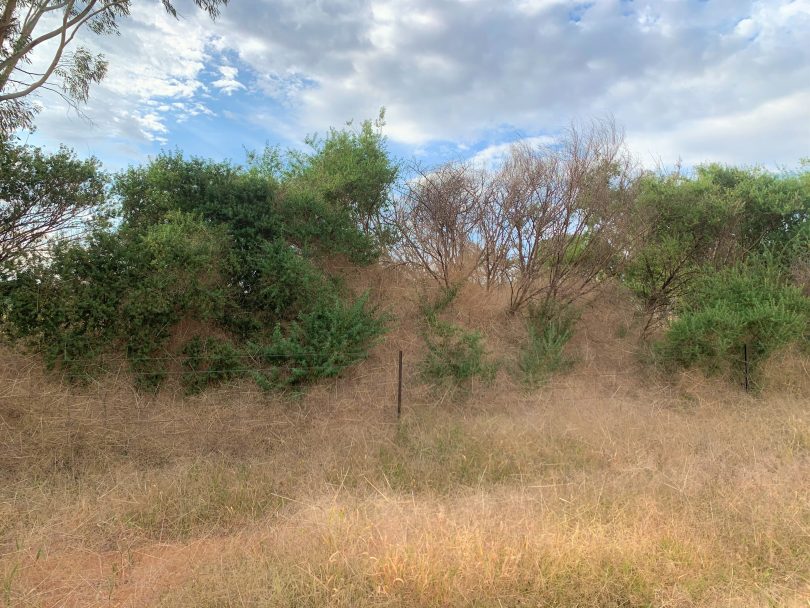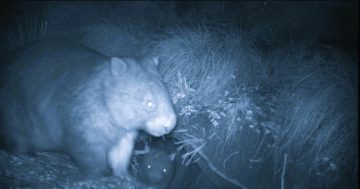
Pepper the kelpie and Salty the border collie battle through a paddock full of panic grass in the NSW South West Slopes. Photo: Edwina Mason.
This past summer of good, frequent rain and warm conditions has resulted in infinite oceans of weeds across regional southern NSW, which is managed by a constant schedule of spraying on farms, in gardens and throughout towns.
But there is a weed that can get away, and when it does, it produces a seed head that, given the chance, attaches itself to anything with a vertical face, leaving farmers frustrated, householders in the dark and livestock lost in pastures.
The life cycle of panic grass might be short lived, and delicious to judicious livestock, but when its spirited tumbleweed-like spawn blows from the mother plant, the inconvenience it causes is enduring. Just ask the people of Wangaratta, Victoria, who were up to their roofs in the stuff in 2016.
Something of a pastoral nomad, its dry, feathery habit goes where the wind blows and, when restricted, forms large, dense clusters which are unshakable due to the tiny hairs on the seed-head working a little like Velcro.
Many believe it is colloquially called hairy panic for that reason.
But this feathery little beast of nature has forced people to tunnel in and out of their houses, and dig their cars out of carports, while others, on farms, are on high alert for obscured fences, rocks, tree stumps and stock.
Short-statured animals are easily lost, as is a week’s worth of washing left untended on the clothesline. Vast tracts of hairy panic on major roads are also an issue.
No matter what instruments are brought out in defence – brooms, rakes, blowers, giant corrugated iron mitts – the menacing seed-head will either compress down in defence, or blow over yonder only to return like a recurring nightmare.
Not to be confused with the uniformly formed umbrella or windmill grass (Chloris truncate) or the almost oat-like Victorian native perennial, awnless blown-grass (Lachnagrostis leviseta), the botanically named Panicum genus includes around 38 different native and exotic species in Australia and 450 worldwide.
PhD candidate at Charles Sturt University’s Graham Centre for Agricultural Innovation, in Wagga Wagga, Yuchi Chen, examined panic grass samples from more than 80 locations in southern NSW in 2017, with some surprising results.

Wading through vast tracts of hairy panic becomes a task in late summer and early autumn. Photo: Edwina Mason.
“It was thought the native hairy panic (Panicum effusum) and introduced weedy panic species witchgrass (P. capillare) were the most common species in the Riverina,” he said. “But our survey found the vast majority, about 90 per cent of samples, were identified as Hillman’s panic grass (P. hillmanii).
“Hairy panic and witchgrass accounted for only five per cent and one per cent of samples, respectively.”
Hillman’s panic grass is a noxious weed introduced from the southern US to South Australia and Victoria in the 1900s and, until recent years, was rarely encountered in NSW.
Charles Sturt University’s Associate Professor Jane Quinn says panic grasses can cause photosensitisation in sheep, resulting in severe skin irritation, fleece loss, liver damage and, in some cases, death.
“Our research aims to profile the potential toxicity of panic grasses to help producers improve their management of outbreaks of photosensitisation in livestock,” she said.
According to Charles Sturt University research professor and plant biologist Leslie Weston, knowing which toxic grass species are present is a key part of this strategy.
“Panic grasses are a leading weed of summer fallows in
grain crops, according to recent GRDC [Grains Research and Development Corporation] weed surveys, and cause significant crop and pasture losses due to competition for resources,” she said.
The Charles Sturt University research team has developed more accurate methods for identifying windswept panic grasses and are evaluating the toxicity levels of individual species.
Professor Weston said current identification of panic grasses typically relies on detailed observation of the structure of the plant and inflorescence (flower head) structure using microscopy.
“But misidentification in archived panic grass samples suggests this is unreliable,” she said.

A tree lot and fence line obscured by the hairy panic weed’s seed-head, which once in this situation rarely moves and becomes compressed over time. Photo: Edwina Mason.
The development of molecular marker-based methods for accurate identification of panic grasses is useful at an early stage of growth.
“This will be important for further strategic control of noxious panic grasses in southern Australia,” said Professor Weston.
In the meantime, she suggests managing the species’ flight across the countryside in late summer and early autumn should stop at the farm gate ahead of the flowering period.
“Some summer weeds are either tolerant or even resistant to the use of systemic herbicides, such as glyphosate, and contact herbicides, such as diquat or paraquat, so careful management coupled with correct identification is important to limiting their spread,” said Professor Weston.
The researchers said reducing the seed bank now will have an impact on the weed burden in coming years.
“A combination of integrated weed management practices and timely chemical control strategies will result in reductions of summer fallow weeds and also reduce inputs into the weed seed bank over time,” said Professor Weston.
As for managing the out-of-control seed-head, she suggests light grazing and mowing, but little can be done once it dries out and winds control their fate.







